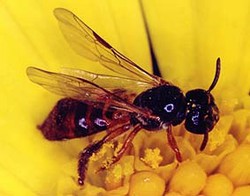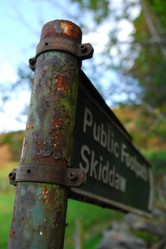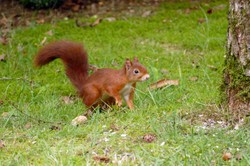Whether you are in Australia's tropical north or in its sandy deserts, you are likely to come across Australian native bees. These colorful insects are vital players in the Australian environment as pollinators of native plants and now are finding a role in Australian agriculture as pollinators of tomato crops.

Australian Native Bees
by AussieBee
Australia has 1,500 of its own species of bees, the Australian native bees. They come in many sizes and colors and are gaining an important new role in Australian agriculture.
Introduction to Australian Native Bees
Australia is home to a large number (more than 1,500) species of bees indigenous to the country: Australian native bees.
Even many Australians are unaware of these bees, although they are to be found in the bushland, parks and gardens of many parts of Australia.
Australian native bees come in a wide variety of colors (black, yellow, red, and even blue and metallic green) and sizes -- from the tiny 2mm long Quasihesma bee to the 24mm long Great Carpenter Bee (Xylocopa).
Australian native bees play a vital role in the pollination of Australian native plants and thus are important for the survival of both Australia's native plants and its native animals.
The best known bee in Australia is the European honey bee (Apis mellifera) which is used for the production of the honey that is sold in supermarkets and for the pollination of crops. However, certain species of the Australian native bees have now been recognized to have important potential as pollinators. University research has been carried out for a number of years into the use of blue banded bees for the pollination of tomatoes being grown in greenhouses. Thus Australian native bees are being seen as an important resource for Australian agriculture.
Blue Banded Bees
Three Groups of Australian Native Bees
The more than 1,500 species of Australian native bees may be divided into three main groups: solitary, semi-social and social.
Solitary
Most Australian native bees are solitary. The female bee lives in each nest, builds the brood cells, provisions them with food, and lays eggs -- all without any help from other bees.
Examples: blue banded bees, teddy bear bees.
Semi-social
Some Australian native bee species are semi-social. In this situation, a series of female bees may help each other, by building the nest burrow and by guarding it cooperatively. However, each female bee lays her own eggs.
Example: Great Carpenter Bee.
Social
A small number of species of Australian native bees -- about ten in all -- are social. This means, that they live in a nest with hundreds or even thousands of other bees, including a queen bee, drones and worker bees.
Examples: The social bees are all in the genera Trigona and Austroplebeia and all are stingless bees.
Teddy Bear Bees
Australian Native Bees as Agricultural Pollinators
Commercial honeybee (Apis mellifera) operations in Australia are currently facing a number of serious threats:
- The South African Small Hive Beetle, Aethina tumida, attacks honeybee hives and has now spread throughout eastern Australia.
- The Varroa Mite, Varroa destructor, which also attacks both feral and honeybee hives has reached New Zealand, just a short distance away from Australia.
- The Colony Collapse Disorder has been causing widespread honeybee losses in the United States and Germany
In the face of the above, alternative insect pollinators need to be urgently sought, in case Australia's honeybees suffer a similar fate to what has already happened in mamny overseas countries.
The importation of one suggested alternative -- European bumblebees (Bombus terrestris) -- for crop pollination poses an unacceptable risk to our native insects, plants and wildlife, should that species escape from their greenhouses.
A better solution is to use Australian native bees as alternative pollinators, particularly:
- The stingless social bees, Trigona and Austroplebeia
- Blue banded bees (Amegilla)
- Leafcutter bees
- Resin bees (Megachile)
The only thing preventing the use of Australian native bees is the lack of research into the most effective ways to use them. Research is already well advanced but more needs to be done. For this reason R&D funds need to be found urgently.
Australian stingless bees - nest entrance
Australian Native Bees on the Internet
AussieBee website
Website promoting Australian Native Bee research and development.
Australian Native Bees - Photo Gallery
Dozens of photographs of Australia's native bees in all their brilliant colors.
You might also like
The Reforestation of SkiddawBritain's project of renewing the Atlantic rain forest is taking a further st...
Rewilding the Isle of the ThundergodTaransay is an uninhabited island one mile off the coast of Harris.but there...





Comments
Thanks for answering all my questions - I'll be keeping my eyes out for sugarbag!!
@Meagan: Thanks for your supportive comment.
No, only the introduced European bees are being used for commercial honey production at this stage in Australia. However, one type of native bee, a stingless bee, makes small amounts of delicious tangy honey. As the native bee industry develops, supplies of this native bee honey, known as Sugarbag, will become more widely available as a niche product.
Aussie native bees are mainly threatened by land clearing and by insecticides that are used in the wrong way. Fortunately they are not affected by some of the worst pests of commercial honeybees such as varroa mites.
This is a really important issue - I hope funds for R&D will be raised. Are Aussie native bees being used for commercial honey production? Is this a potential growth industry? And are Aussie natives vulnerable to the same threats? Thanks for an informative page.
@DavidPaulWagner: I appreciate your comment.
@Digby_Adams: Thank you! I hope to add more pages on different Australian native bee topics as time goes by.
It's great that you're trying to teach people about the importance of bees in our world. I learned a lot about the bees of Australia - certainly fascinating. Welcome to Wizzley!
Great introduction to Australia's own "dinky di" bees!